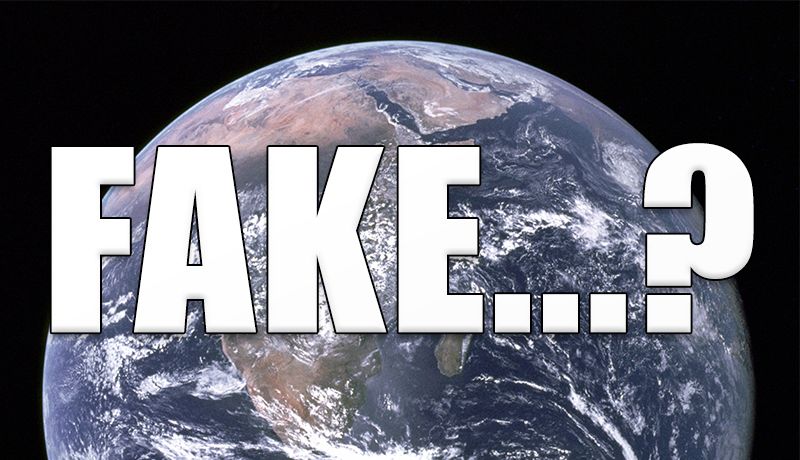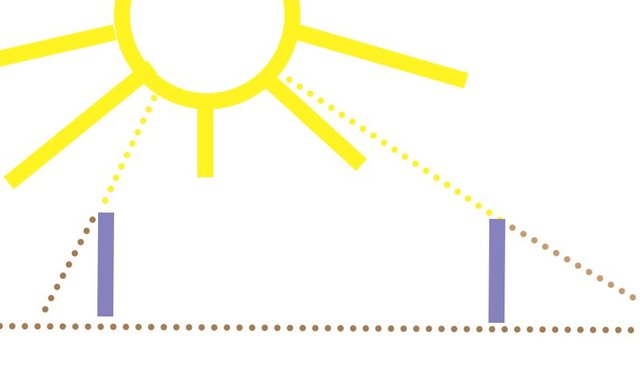What shape is the earth?: Why to argue responsibly

When you ask most people the shape of the earth, they will say that the question is simple - the earth is a ball - more specifically, a sphere or an oblate spheroid. But when you ask them how they know, things start to get a little trickier. The amount of people who have a legitimate claim of having seen the earth’s shape first-hand is very limited, probably in the hundreds or less. So, “knowing” that the earth is a ball, and feeling that they have to defend this position, they begin by presenting a number of easily-refuted arguments.
I also presented this case in video format if you prefer: Flat-earthers and Globeheads: The argument about the shape of the earth.
Eratosthenes and his big sticks
Many bring up the famous experiment of Eratosthenes which he performed around 200 BC. The experiment went like this:
E. had access to two specific pieces of data. He had two sticks in the ground, one in Alexandria and one in Syene. These sticks were of the same length, so when they cast shadows of different lengths he could use that information to calculate the circumference of the earth. Therefore, the argument goes, the earth is a spheroid.
The problem with that argument is, that’s not what E. proved with the experiment. The experiment assumes that the earth is a spheroid, and that the sun is very far away - so far away that its rays are virtually parallel. The calculations only work if you make these assumptions. If you think about it for a moment, you can imagine how a sun could cast shadows of different lengths on a flat plane, or almost any other shape of earth. All it would take would be for the sun to be close enough to the plane that the rays weren’t parallel. So when people use E. as an argument for a spheroid earth, they are actually assuming what is to be proven.

Nice use of Photoshop
Planets are spherical and the Aardvark analogy
All the planets we see in the sky are spheroids, they say. The moon is a spheroid. Why wouldn’t Earth be a spheroid?
Firstly, this is a little bit of a questionable assertion because again, there are only a few people who really have the knowledge to say that the planets in the sky are spheroids. Most of us have never even looked through a telescope to see Mars, and we take it on faith that Mars is a spheroid. There is even some information (questionable, but fascinating, information) that implies that the planets are just floating luminescent gases of no fixed shape.
At least with the moon, we can see quite easily that the shadows cast on it at different times of the month imply a spheroid.
Secondly, even assuming that the moon and all the planets in the sky are spheroids, this argument still fails.
Imagine you and I are standing in a room with three mysterious doors. You open the first door and find a rabbit. “How cute,” we say. I open the second door and find another rabbit, and feed it some hypothetical lettuce. We pause on the third door, and decide to make a bet. You say to me “The first door and the second door had rabbits behind it. That means the third door also has a rabbit behind it. I mean, why wouldn’t it?”
I respond “Actually, the contents of the first and second rooms don’t necessarily affect the contents of the third room. There could be anything behind this third door. Perhaps there is an aardvark behind this door. Perhaps there is just air. I bet you $100 that there is something other than a rabbit behind this door.”
When we finally open the door, we find… well, it doesn’t matter what we find. The analogy is just to illustrate that the question “Why wouldn’t there be a rabbit?” doesn’t really help us to determine what is. The identification of the rabbit trend is valuable information, and we can take it into account - but there is no way it can tell us conclusively what is behind the third door. Likewise, the shapes of the planets in the sky can never conclusively tell us the shape of the earth.
I’m pretty sure gravity exists, dude
Some will tell you that if the earth is a plane, or some shape other than a ball, there is no way we could approach the edges, as in this fascinating video by V sauce:
The video’s premise is that, if the earth were a plane, and we approached the edges, we would be drawn towards the centre of the earth, making it increasingly difficult to move, as every step we took farther from the centre would be like walking up a steeper and steeper hill.
My response to that is “How do you know gravity exists?”
To which people normally say “I’m pretty sure gravity exists, dude. Things fall when you drop them.”
This is interesting, because it shows how ingrained an idea like gravity can be in the popular consciousness. To many people, the idea that “things fall when you drop them” is indistinguishable from the Newtonian concept of gravity, in which massive objects attract each other, (reportedly) explaining the movements of celestial bodies. In fact, those are related, but clearly distinct, concepts. People knew that things fell when they were dropped well before Newton, and their tendency to fall doesn’t inevitably lead to the idea that “a particle attracts every other particle in the universe” - at least, it doesn’t without more data.
NASA fakery & space age fuckery
Once upon a time, it was widely believed that “the camera doesn’t lie”. Now, in this enlightened age of the Internet, we know that is certainly not the case. People have been doctoring photos pretty much since photos existed. Here is a photo that shows where Stalin had an ex-friend edited out.

We also know these days that hyperrealism in paintings is absolutely possible. Some artists have developed such skill in painting that their work is indistinguishable from photos.

So when you see images like these:

Can you say without checking which ones are real, and which ones were created on a home computer? In fact, the bottom left image I picked up from Deviant Art (DragoniteTrainer on Deviantart. The others are from NASA.
When people base their view of how the universe is structured on some pictures, people are right to be skeptical. It’s possible that organisations have sent crafts to space - many will mention the independent verifications of that - and that they took pictures, and that these are those pictures that were taken. However, as the skeptic’s mantra goes, extraordinary claims require extraordinary evidence. Pictures of the earth as a round thing don’t prove that the earth is a globe any more than a photo of Stalin standing by a river alone proves that Nikolai Yezhov wasn’t standing with him at the moment the photo was taken.
On the other side, we have footage which purports to demonstrate NASA fakery, showing astronauts creating the illusion that they are far away from a spheroid earth
And a response here, attempting to show that “A funny thing happened on the way to the moon” misrepresented the footage:
High quality evidence from a surveyor
The best evidence that I’ve seen so far that demonstrates the curvature of the earth, is surveying data from my acquaintance Jesse Kozlowski. In some of his older videos (which unfortunately he has taken down) he made the case that if you take three points on a flat plane, the three angles formed between the points should add up to 180 degrees. On a concave object, they would be less than 180 degrees, and on a convex object (such as a globe) they would be more than 180 degrees. According to Kozlowski, surveyors have been making these measurements for many years, and the sum of the angles will almost always be more than 180 degrees.
In this video, Kozlowski creates a level surface near a lake using a spirit level. He then views from that from that point, horizontally across. On a flat plane, you would expect that he would see something at a similar height on the other side of the lake. In fact, he shows that the point directly horizontally across is several feet higher compared to the surface of the lake. This implies that the surface is curved.
“200 Proofs Earth is Not a Spinning Ball”
“200 Proofs Earth is Not a Spinning Ball” is a document that many people will hold up as a good place to start when you research flat earth ideas.
While some points that it raises might be headscratchers and get you wondering about physics, or require hours of calculations for a layperson to confirm or deny, many can be disproven with a little research.
Blunders
7. Surveyors don’t take curvature into account
Surveyors, engineers and architects are never required to factor the supposed curvature of the Earth into their projects.
As we’ve seen with Kozlowski’s measurements above, surveyors and engineers do indeed account for the curvature of the earth. In fact, there are entire fields of surveying and engineering dedicated to that very subject, known as “geodetics” or “geodesy”. Here are some relevant links: Geodetic surveying - Civil Engineer’s Forum, Geodesy on Wikipedia.
40. From Cape Horn to Melbourne
From near Cape Horn, Chile to Port Philip in Melbourne, Australia the distance is 10,500 miles, or 143 degrees of longitude away. Factoring in the remaining degrees to 360 makes for a total distance of 26,430 miles around this particular latitude, which is over 1500 miles wider than Earth is supposed to be at the equator, and many more thousands of miles wider than it is supposed to be at such Southern latitudes.
Well, that’s not right. According to Google Maps, the distance between Cape Horn and Melbourne is less than 9,200 km, around 5,700 miles.
42. Captain Cook’s trip to Antartica
In the ball-Earth model Antarctica is an ice continent which covers the bottom of the ball from 78 degrees South latitude to 90 and is therefore not more than 12,000 miles in circumference. Many early explorers including Captian Cook and James Clark Ross, however, in attempting Antarctic circumnavigation took 3 to 4 years and clocked 50-60,000 miles around.
At first, I could find no mention of Cook’s exploration of Antarctica. Eventually, I did find this source:
Although his intentions were to continue to England, his temptation to the south could not be resisted and at the end of January he sighted a group of islands even more desolate than South Georgia. These he named the South Sandwich Islands. After a week of exploration in them, he turned north for England, reaching England on July 30, 1775. The voyage lasted three years and eight days covering more than 60,000 miles. Cook had proved there was no southern continent unless it was at the pole itself.
Obviously this is talking about a voyage of three years and 60,000 miles total - not just around the Antarctic region. It’s worth noting that it would take more than 7,500 miles of sailing in the leg from the South Sandwich Islands to England alone.
Conclusion
I’m quick to admit that I really don’t know what the earth’s shape is. Based on the data available, I do think it’s much more likely that the earth is curved, rather than flat, and there’s certainly a possibility that the earth is an oblate spheroid. One of the key problems in this public discussion seems to be that many people in the globe earth side of the debate are very certain of their position, but they’ve never had reason to defend it, so their arguments are very weak. This means that the discussion gets muddied with bad arguments, and may have the opposite effect of that intended.
If you want to get involved in a controversial debate, and your intention is to get closer to the truth, it is vital that you take the responsibility to be informed, to analyse your arguments before they’re ever displayed on a public forum, and ideally, to start from a position of very limited assumptions - even starting with the position that “I don’t know what the shape of the earth is.”
Of course, I remain open to arguments and evidence of every side of the debate - showing that the earth is spheroidal, disc-shaped, a flat plane, hollow, concave, or even a four dimensional model in which the earth’s shape changes depending on your perspective. Good luck, and above all: remember to bring your A game when involved in crazy arguments.
About me

My name is Kurt Robinson. I grew up in Australia, but now I live in Guadalajara, Jalisco. I write interesting things about voluntaryism, futurism, science fiction, travelling Latin America, and psychedelics. Remember to press follow so you can stay up to date with all the cool shit I post, and follow our podcast where we talk about crazy ideas for open-minded people, here: @paradise-paradox, like The Paradise Paradox on Facebook here, and subscribe to The Paradise Paradox on YouTube, and on iTunes
I have been curious on all the flat earth stuff lately only in interest still firmly feeling confident the earth is infact round and space exists and planets and galaxies and other suns yada yada, I even still believe we have gone to space, but with all the lies coming out over the years I sorda have an open ear to all thoughts suspicions and ideas people may have, its def interesting.
My reason for still believing with confidence is a long time fascination with space, science and astrophysics, most of it goes over my head, but a lot of respected people in these fields if not all believe the earth is infact round, and the amount of people that would have to be involved in a flat earth cover up would be astronomical over the years. I think its very possible some space missions were faked but I dont think most of them were if any, as again the amount of people involved would be much higher than people I think would assume.
I really like your post, you went in hard with some interesting facts!
in conclusion, I never seen the earth first hand, but I feel like .... its round ;)
here is a question thought? What does it mean if the earth is flat?? Who would gain from hiding this fact?? or just What does it mean to you if the earth is not infact "Round"?
Those are some fun questions... I did explore them a little bit in this video:
got a little mighty boosh in that intro i was crackin up loved it! thanks for dropping this in the reply to me, enjoyed the watch!
I must admit some of the reasoning here makes me feel.......like im banging my head against a wall and the wall is a soggy sponge and splashing and sucking the top of my head with each bang pulling out my brain through my hair follicles and absorbing it feeding a large hungry monster that I live inside.......
strange I know but this is my dominant paradigm in feeling while listening to your monotone facts with the droning sound track of impending doom and deception.....
you know I think I need an ice cream cone, and to stick my feet in some mud on a sunny day, with the wind slightly breezing by a lake....
this is just to heavy. I may be de - evolving for having heard this.
;)
As we used to travel out to the Cantarell oilfield in the Gulf of Mexico, we would only the the tops of the platforms when they first came into view.
As we approached, more of the platform would come into view.
well it's actually pretty easy.
get a weather ballon...fill it with helium
attach a go-pro...let it go.
the higher it goes the more the curvature of the horizon is visible.
simple.
That's good, but again, it's not quite that simple. For one thing, normally it can be difficult to determine whether it's the curvature of the lens or the curvature of the earth. Some people have even sent me skydiving photos where the earth was curved, but on closer inspection, it was almost certainly the lens causing it.
The other thing is, even if footage like that does prove the earth is curve, that does not prove the earth is a ball.
it's either a sphere or it's a plane...
if it's a plane then where are the edges.
odd...I've been around it a few times...never saw any edges...
I don't see how you can start like that. Why would it possibly be limited to only those options?
you got 2D (a plane)
you got 3D (a solid)
what else is there?
A sphere isn't the only three-dimensional shape.
I like donuts myself.
Donuts are nice
I think you can chalk this one up to an appeal to authority argument, which in this particular case I'm fine with. I don't usually like those kinds of arguments with a lot of different subjects, particularly philosophy and economics, but this is simply about empiricism. The requirements for me to go out and make the necessary observations to prove or disprove a flat earth theory are so incredibly laborious that I'm not even interested enough to attempt them. I'm not a navigator, a sailor, a rocket builder, an astronomer or even a professional builder of large structures, so an incorrect assumption will not effect my daily life or work in any way shape or form. Others have already done all of that hard work because it was important to their professional integrity in the above listed fields of study (among others), and all of the observations I've made in my lifetime, while not proof, corroborate with the testimony of the experts. I have no reason to disbelieve them, and no incentive to become expert in their fields. It kind of astonishes me that people who have no skin in the game spend so much of their time worrying about this stuff, trying to refute people who are experts without becoming experts and making the observations for themselves. It also astonishes me the people who try to refute their arguments without realizing that they're making an appeal to authority argument, and simply just saying that. "The experts know more about this than you. I'm not an expert, but I trust their opinion more than yours." Personally, I choose not to engage people who push the flat earth theory because I really don't see what I could gain from it.
Earth's shape is like a giant meteor shaped like a potato
...Yes.
Great post @churdtzu! I am happy to see you always thinking . I have been exploring this topic for nearly two years now and it just gets richer.... your approach is practical and emotionless which is important. I just had an anonymous private youtube message telling me not to speak about flat earth! Thats weird. Of course thats just made me wanna research more and talk about it all the time now.. . .
Thanks Elissa! It's kinda funny how people get so worked up about this stuff on Facebook. I didn't even say that the earth was flat and a few folks are willing to call heretic. Haha.
I hope everything is going great for you
yes i had some baad cognitive dissonance at the start and had to work through my own ego before i could even start to remind myself the "proofs that proved I was on a globe..." so much deception in every direction
all the best to you and yours Kurt!
I've only looked into this a little bit, but I'll say I think the Flat earth debate is actually a wonderful thing. Why? Because we can only benefit from it.
If it is correct, then obviously it's important to know the truth and that would obviously change quite a few things.
If it is incorrect, it is a wonderful opportunity to engage people with science.
I don't think anyone should be angry with people who question the sphere earth idea and scientists should never make fun of anyone who does, because in science all questions are supposed to be valid and anyone who is interested enough to be asking questions is a potential future scientist.
I'll be looking more and more into this idea over time, either to learn a new truth, or to sharpen my understanding the scientific principles involved here.
Thanks for sharing.
Thanks @trevorlyman. You're so right, science is supposed to be about asking questions, and flat earthers definitely have a lot of interesting questions to raise. Even something as simple as, "why are sundogs round?" can send you down a rabbit hole.
I had never even heard of Sundogs. See! You're proving my point. I'm learning because of the questions you are asking. Thank you! :)
Time to rewrite the history book lol
Excellent post! I'm following all flat Earth researchers and free thinkers I come across on steemit.